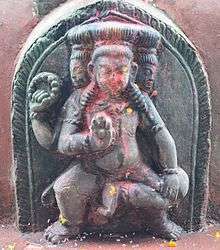Jvarasura
| Jvarasura | |
|---|---|
 | |
| Devanagari | ज्वारासुर |
| Tamil script | ஜ்வரஷுற |
| Bengali | জ্বরাসুর |
| Affiliation | Asura |
| Consort | Shitala |
Jvarasura also called Jwarasura (Hindi: ज्वारासुरा) in Hindu mythology is the fever-deity and consort of pox-deity goddess, Shitala.
In Hindu mythology
According to one legend, Jvarasura was born out of sweat of the fore-head of meditating Shiva and was threat to Gods. Once Vishnu was inflicted with fever of Javarasura, when in form of Haya-griva. He killed the fever-demon, Jvarasura.[1][2] by cutting him into three pieces using his, cosmic-disk weapon, the Sudarshana Chakra. However, Jvarasura was later revived by Brahma, who joined the three parts. But by that time each three parts had grown head and limbs. Thus Jvarasura is depicted as having three faces, three feet and remarkable ability to move in all directions at once. He was later selected as consort of pox-goddess, Shitala.[1]
The cult of Shitala-Jvarasura is widely popular in Bengali culture. Incidentally, in Bengali, Oriya and Hindi languages, fever is referred to as Jvara.[3] and Asura means demon. The name Jvarasura is combination of these two words - Jvara (meaning fever) and Asura (meaning demon) - Jvarasura. Thus, Jvarasura means the demon of fever. It is said that Shitala & Jvarasura travel together on their mount of Donkey. Jvarasura is disguised as a young servant. Shitala, the consort of Jvarasura is widely worshiped by village folk in whole of North India, as a protector of pox and fever diseases.[4]
In Buddhism
In Buddhist culture, Jvarasura is depicted sometimes as consort of Paranasabari, the Buddhist Goddess of diseases. In some images these deities are shown as flying away to escape from wrath of Vajrayogini, the Buddhist Goddess and destroyer of diseases.[2]
References
- 1 2 The Divine consort: Rādhā and the goddesses of India By John Stratton Hawley, Harvard University. Center for the Study of World Religions. 1982.
- 1 2 P. K. Mishra (1999). Studies in Hindu and Buddhist art.
- ↑ Alf Hiltebeitel (1991). On Hindu ritual and the goddess.
- ↑ Fruits of worship: practical religion in Bengal By Ralph W. Nicholas. 2003.